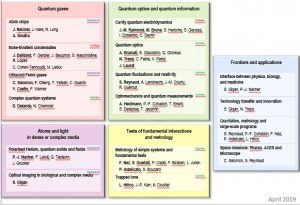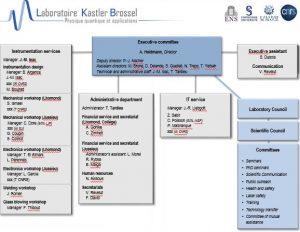Laboratory presentation
The Kastler Brossel Laboratory (LKB) is a joint research unit of the Ecole Normale Supérieure, Sorbonne University, Collège de France and CNRS It is one of the main leaders worldwide in the domain of fundamental physics of quantum systems, covering numerous subjects from fundamental tests of quantum theory to applications, with an internationally recognized expertise throughout its 65 years history, including three Nobel Prize winners.
The traditional activities of the laboratory is in atomic physics and optics, with a particular emphasis in fundamental issues of light-matter interaction, quantum states of light and precision spectroscopy. One of the important developments in recent decades concerns cooling and trapping of neutral atoms, which have opened up a rich field of study on quantum gases and liquids, at the boundary between atomic and condensed matter physics. Another strength of the laboratory is the study of the interaction between photons and atoms with fundamental contributions in the field of cavity quantum electrodynamics, quantum optics and quantum information, and optomechanics. While these concepts continue to play a central role at LKB, the laboratory has also diversified its research themes towards nanophotonics, Casimir effect, imaging in biological and complex media, trapped ions, metrology and the tests of fundamental interactions. LKB participates in several large-scale programs and collaborations at the national and international levels such as GBAR, Virgo, several space missions and French programs of excellence (Equipex).
Research and organization of the laboratory
The laboratory is composed of a majority of young researchers, with 56 researchers, professors and assistant professors, about 70 PhD students and 30 post-doctoral students. The laboratory is composed of 12 research teams distributed into 5 axes:
– Quantum optics and quantum information
– Atoms and light in dense or complex media
– Tests of fundamental interaction and metrology

The laboratory has 4 members of the French Science Academy, 3 professors at the Collège de France, in activity or emeritus. It is also heavily involved in teaching activities, the quality of its professors and assistant professors being well recognized by numerous appointments as junior or senior members of the Institut Universitaire de France (IUF).

The support services are composed of 25 engineers and technicians. They are organized into four divisions: administrative services, instrumentation services, IT services, management support and communication.
The laboratory is managed since 2012 by Antoine Heidmann. The Executive Committee is also composed of Pierre-Jean Nacher (Deputy Director), Michel Brune, Dominique Delande, Philippe Jacquier and Nicolas Treps (Assistant Directors), Thierry Tardieu (Administrator) and Jean-Michel Isac (Head of Technical Services). The organization chart specifies the different structures of the laboratory.
The LKB is located on three different sites, close to each other in Paris 5th: the Ecole Normale Supérieure, 24 rue Lhomond ; Sorbonne University (Pierre and Marie Curie campus), 4 place Jussieu and the Collège de France, 11 place Marcelin-Berthelot.
A brief history of the laboratory
From 1951 until 1994, the laboratory was named the Laboratoire de Spectroscopie Hertzienne de l’ENS. Its current name is a tribute to its two co-founders, who made pioneering contributions to modern physics about light-matter interaction. Their work led to Alfred Kastler’s Nobel Prize in 1966. The laboratory then experienced a rapid expansion, and several teams moved in 1967 to the new university under construction in Jussieu.
With the advent of lasers, new research themes were developed in the 1970s and 1980s, leading to the seminal work of Claude Cohen-Tannoudji (Nobel Prize 1997) on the cooling and trapping of neutral atoms. In parallel, Serge Haroche has conducted research that led to the development of cavity quantum electrodynamics (Nobel Prize 2012). In recent years, the LKB has celebrated the anniversaries of two of its Nobel Prize winners: the 50th anniversary of Kastler’s prize in 2016 and the 20th anniversary of the Cohen-Tannoudji’s prize in 2017. In 2014, some of the laboratory’s teams moved to the new Physics Institute at the Collège de France, which became the fourth supervising institution of the laboratory.
